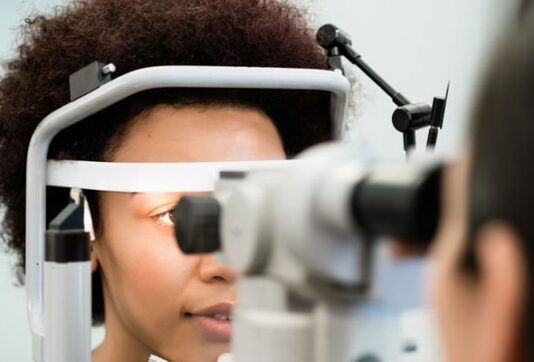Contact Lens Exams in Seattle
The first step toward getting contact lenses is to have a contact lens exam. That will provide you and our eye doctors important information about the health of your eyes, your vision, and whether you’re a good candidate for contacts. This exam includes a standard eye exam, but it goes a step further to ensure that you don’t have corneal irregularities, dry eye, or other issues that might make wearing contact lenses difficult. If you do have irregular or damaged corneas, our optometrists will discuss your options with you.
The Importance of a Contact Lens Exam
Contact lenses provide a more natural look for vision correction. At Cannon EyeCare in Seattle, WA, we prescribe various types of soft contact lenses to help you see clearly and improve your quality of life. Before visiting us, learn more about contact lenses below:
Choosing the Right Lenses for Your Eyes
After your exam, we will work closely with you to find the right lenses for your specific needs. Most people choose soft lenses, but that’s not the only option. You may be a better candidate for rigid gas-permeable lenses, also known as RGP, or even scleral lenses. These lenses sit on the white part of the eye known as the sclera and allow those with irregular corneas to wear contact lenses comfortably.
Even among the most used soft lens style, there are many different types. Some are replaced monthly and others are single-use “Daily Disposable” lenses. There are some that can clear up the blur from astigmatism, and many patients over 40 wear “multifocal” lenses.
Quality Lenses Will Improve Your Vision
Our optometrists will suggest quality lenses that will make everyday tasks like reading, driving, and even playing sports easier. Our eye doctors will take the time to talk to you about safe wearing habits. Good hygiene and avoiding CLOW (Contact Lens Over-Wear) are crucial. We will also help you with the contact lens insertion and removal; in fact this training is required for all new wearers in our practice.
Contact Us for an Appointment Today
If you are considering contact lenses, our team at Cannon EyeCare in Seattle, WA, is happy to help. To schedule your exam, contact our office at (206) 448-7739 today. You can also browse our website to find out about our services or visit us in person. When you are in the Seattle Metro and looking for an “optometrist near me”, we look forward to assisting you!
Eye exam for contacts
A contact lens exam will provide you with a comprehensive eye exam (all the health checks described in the Eyeglass Exams), in addition to a contact lens fitting. This exam will result in a contact lens prescription (allowing you to buy contacts).
Washington state law requires that all patients have their eye health checked prior to being fit in contacts, so it is not legal (or safe) to do a contact lens fitting alone without an eye exam. This regulation is really there to keep you, the patient, safe. The goal here is to ensure that the eyes are healthy enough to wear contact lenses.

What to Expect at Your Appointment
Preparing for Your Visit
-
Wear your current contact lenses to your appointment.
-
Bring documentation of your prescription (brand and power), especially if lenses were prescribed elsewhere.
-
No records? Don’t worry—we’ll still ensure a precise fit!
During Your Exam
Our Seattle optometrists will:
-
Evaluate your current lenses for fit and comfort.
-
Perform specialized tests to assess corneal health and vision needs.
-
Discuss new options—like daily disposables or multifocal lenses—if your eyes could benefit from updates.
Why Annual Evaluations Matter
Washington state requires yearly exams to:
-
Ensure your eyes stay healthy.
-
Update prescriptions, even if your vision seems unchanged.
-
Cover follow-up visits and trial lenses at no extra cost (unless treating conditions like dry eye).
After Your Appointment
Most patients leave with trial lenses and finalize their prescriptions via a quick email or call. We make it easy!
Types of Lenses & Costs
Spherical Contact Lenses: Affordable Single Vision Solutions
Spherical contact lenses correct single vision without astigmatism, offering a straightforward fit for most patients. With a simplified design, spherical lenses are budget-friendly at just $100 for fitting. Ideal for those needing basic distance or near vision correction, these lenses are a cost-effective choice for standard prescriptions.
Toric Contact Lenses: Precision Correction for Astigmatism
Toric contact lenses address astigmatism with advanced curvature to focus light accurately. Due to their complex design, toric lens fittings cost 120 and 140 for specialty lenses. These lenses ensure optimal clarity for patients with irregular corneal shapes, balancing precision and value.
Multifocal & Monovision Lenses: Solutions for Presbyopia
Multifocal or monovision contact lenses cater to presbyopia (age-related near vision loss). These fittings require detailed customization, often needing follow-ups, with a fee of 140. Specialty multifocal or monovision lenses may cost up to 160 in rare cases. Perfect for patients over 40, these options blend distance, intermediate, and near vision correction.
Vision Insurance & Out-of-Pocket Costs
Vision insurance may partially cover contact lens fittings. Without insurance, a $195 comprehensive eye exam (including refraction) applies alongside fitting fees. Discuss coverage with your provider to estimate expenses.
Hard (RGP) Contact Lenses: Discontinued Fittings
Rigid Gas Permeable (RGP) lenses are rarely used today. Our clinic no longer offers RGP fittings due to declining demand and patient preference for soft lenses.
Presbyopia Solutions: Distance Lenses + Readers vs. Advanced Options
Many patients over 40 ask, “Can I wear contacts if I need bifocals?” Solutions include:
-
Distance Contacts + Readers: Affordable but requires wearing reading glasses over contacts.
-
Monovision Contacts: One eye for distance, the other for near.
-
Multifocal Contacts: High-tech lenses with blended vision at all distances.
Monovision Contacts: Dual-Focus Adaptation
Monovision assigns your dominant eye for distance and the other for near/computer vision. While 80% of patients adapt successfully, depth perception may dip temporarily. Not recommended for surgeons, athletes, or detail-oriented tasks. Though intermediate vision may lag, monovision remains a proven, decades-old strategy.
Multifocal Contact Lenses: Advanced All-Distance Vision
Multifocal lenses use concentric ring technology to blend distance, intermediate, and near powers. Vision won’t be perfect at any range but functional for daily tasks. Adhering to the 80% Rule, patients achieve clear vision 80% of the time without readers. Expect slight ghosting due to overlapping focal zones, but modern designs like Acuvue Oasys Multifocal deliver impressive 20/20 distance and 20/25 near vision for adaptable wearers.
Contact Lenses for Children: Safety, Maturity & Success Stories
We typically fit contacts at age 13+, but exceptions exist for motivated, hygienic children. A 9-year-old gymnast, for example, transitioned to ballet with contacts after glasses hindered her performance. Dr. Mark Cannon emphasizes hygiene and responsibility during fittings, ensuring young wearers understand lens care.
The Process
At Cannon EyeCare, your doctor will likely perform most of the following tests. For a basic overview of these tests, please refer to the EyeGlass Exam service description. The following details how these test are utilized to help with a contact lens fitting.
Visual acuity testing – ideally we test your vision in your current contacts; this is one of the best reasons to wear your existing lenses into the eye exam for contacts. If you have to come in wearing your glasses instead, that will work too.
Cover Test – again, it’s best if we can do this test where we cover one eye, then the other, with your contact lenses on. If you have prism in your glasses, be sure to bring those as well.
Side Vision Test – sometimes this test is a little easier for patients who are doing their eye exam with contacts on, as the glasses frame won’t block your side vision.
Auto-Refractor – we will have you take your contacts out prior to this test. The info we get from auto-refraction serves as a starting point for refraction.
Air Puff Test – nobody really loves this test, but it is an important glaucoma screener that tells the doctor about the pressure inside of your eyes. We will test you with contacts off.
Refraction – this is the old “one-or-two test’ that optometrists are kind of famous for. There is no difference in how this test proceeds in an eye exam for contacts vs. an eyeglass exam.
Auto-Keratometry – this quick automated test determines if your cornea is perfectly spherical or is somewhat warped (astigmatic). This info can help the optometrist perfect your glasses Rx, which may in turn lead to a toric contact lens Rx. This test also gives the eye doctor some info about whether to try you in a tighter or looser fitting contact lens.
Eye Health Exam – your eye doctor will use a slit lamp to check all of the key structures of your eyes. They will pay special attention to the lids, tear film, and the corneal health of patients who wear (or plan to wear) contact lenses.
Dilation – there is no real difference in this test for glasses and contact lens wearers. See the EyeGlass Exam service type for our thoughts on dilation.
Your optometrist will review your medical history and discuss finalizing your contact lens prescription (Rx) during your appointment. In many cases, we can issue your finalized contact lens prescription the same day as your initial visit, providing a printed copy for immediate use. However, some patients may require trial contact lenses to ensure optimal fit and comfort. We emphasize scheduling contact lens follow-up appointments promptly, as Washington state law mandates completing the contact lens fitting process within a 6-month window. Delays beyond this period require an additional eye health exam under state regulations, accompanied by a prescription renewal fee. Timely follow-ups help avoid extra costs and ensure your contact lens Rx meets all vision and health standards efficiently.
Insurance
We are in network with the major local health insurance companies. Cannon EyeCare does not accept any 3rd party vision plans such as VSP, Davis, or EyeMed due to unreasonable contractual stipulations.
Insurance We Take
Insurance We Don’t Take
FAQs
-
Why is a contact lens exam required
Washington state law mandates a comprehensive eye health exam before contact lens fittings to ensure your eyes are healthy enough for lenses. This prevents complications like corneal damage or infections, prioritizing patient safety.
-
How much does a contact lens exam cost in Seattle?
-
What’s the difference between monovision and multifocal contacts?
-
Can children wear contact lenses in Seattle?
-
How do I prepare for a contact lens exam?
-
Will insurance cover my contact lens exam?
-
What types of contact lenses are available?
-
Why choose multifocal contacts over glasses?
-
How often do I need a contact lens exam?
-
Where can I get a contact lens exam in Seattle?
